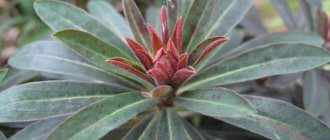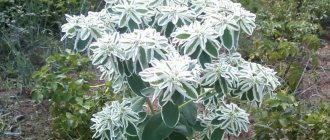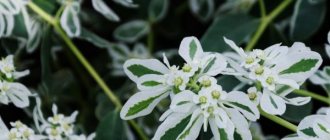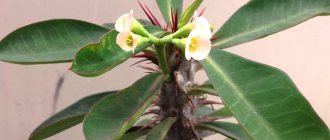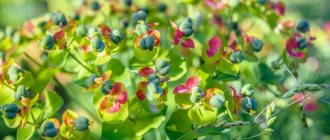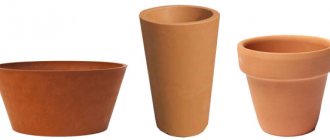Plants » Flowers
0
3226
Article rating
Kira Stoletova
Species of milkweed are very popular among flower growers, professionals and amateurs. These plants are varied in form, but equally poisonous in content. Euphorbia Euphorbia Lactea cristata has the most unusual form.
Euphorbia Lactea cristata
Milk spurge is difficult to find on shelves. This is a special decorative crop, the best choice for true connoisseurs and lovers of extravagant forms.
About Milkweed
Euphorbia lactea f. cristata belongs to the large plant family Euphorbiaceae.
This family is characterized by a variety of forms, as can be seen from numerous photos. Even an inexperienced gardener cannot confuse Milkweed with another plant.
Euphorbia Lactea is a succulent perennial plant. She comes from the Asian tropics. In the wild, Milkweed has large and powerful shoots of an unusual shape that is difficult to describe. In Lactea cristata culture, it is most often grafted onto other species of the family. The spurge of milkweed is shaped like a rounded comb or fan.
Milkweeds are prone to mutations. Two mutational forms are known:
- variegated (no ability to photosynthesize);
- cristate.
Cristates are the most popular among gardeners. They do not lack chlorophyll, they produce energy for themselves, so Lactea Cristata (f. cristata) can grow independently, on its roots. Variegata cristata (f. cristata f.variegata) must be grafted onto another euphorbia.
Most often, the comb of Euphorbia cristata is grafted onto a more stable and unpretentious stem species. In stores you can find a scallop with a ribbed, bright green stem.
Botanical description
Euphorbia cristata is a very interesting plant in shape, representing a kind of dense comb on a thick stalk. The rich, bright green color of the leg clearly contrasts with the delicately light comb, whose color shimmers from milky white to light green. The spines and top of the ridge are colored from soft pink to almost red. The leg is also protected by thin long spines, preventing anyone from getting close to it.
In the wild and gardens, milkweed has fairly long, dark green leaves, but at home they quickly dry out and die off on their own.
Like all representatives of this family, euphorbia Lactea has a poison similar in appearance to milk. Although seemingly harmless, this poison can cause burns and poisoning, so you should be very careful when handling it - wear protective gloves, store it out of the reach of children and pets, and wash your hands thoroughly after contact.
Cristate form
Euphorbia Lactea cristata attracts gardeners with its extraordinary shape. The silhouette of the plant resembles an open fan. Some compare it to coral. The shoot has irregularities, outgrowths, and teeth and thorns are visible along the edges.
Euphorbia also has a very unusual color. The light green shoot has a white center point. Some plants are decorated with reddish thorns. The edges of the fan are often covered with a pinkish coating. There are varieties that have a metallic tint in color.
Euphorbia cristata is a flowering plant. The flowers are located on the edges of the scallop. They are very small in size, so they are almost invisible. Blooming spurge at home is a rare and exceptional phenomenon.
How to care for Euphorbia Lactea
Growing and preserving Crested spurge at home is very difficult. This is an unusual plant and standard care rules do not suit it.
Caring for Kristata should be unobtrusive, but very careful and attentive. The plant has a dual nature. It is necessary to take into account the growth characteristics of the scion and rootstock. Euphorbia Lactea can develop normally in the temperature and light conditions of the room. The plant does not tolerate heat or cold equally well.
Improper care at home leads to the loss of the plant. Before purchasing and starting to grow milkweed, you need to carefully study all the features of the growth and development of euphorbia.
Diseases
Since milkweed is a poisonous plant, it is not afraid of pests, but there is another disease to which this plant is often susceptible. This disease is rot, which affects the beautiful comb. The only way to cure it is to cut off the rotting part to a healthy area, leaving no part of the rot.
In most cases, caring for this unusual plant does not cause problems. With great pleasure, you can grow the following varieties of milkweed: Mountain Snow, White-veined, Multi-flowered, Bordered, Comb, Fat, Wild.
Features of watering and fertilizing
When growing Euphorbia Cristata at home, special attention is paid to watering. To keep the ridges large and fleshy, you need to constantly maintain moderate soil moisture. Dryness or excessive moisture can lead to the death of the rootstock. Excessive moisture promotes rotting, and with a lack of moisture the shoot dries out.
There is no need to water Euphorbia often. Watering regime for Milk milkweed depending on the season:
- Spring and summer. Watering is carried out once every 10 days.
- Late autumn and winter. Euphorbia is watered once every 30 days.
With this mode, in the interval between waterings, the top layer of soil dries completely. The middle layer of soil retains a small amount of moisture. After watering, optimal humidity is created in a short time.
Euphorbia does not tolerate humid air. Do not spray the plant. The rootstock and cristate area may die if wet.
Fertilizers can be applied only in summer and spring, no more than once a month. For Lactea, special fertilizers for cacti are selected.
Varieties and photos
Although euphorbia is an inconspicuous flower, it can often be seen in the flowerbeds of summer residents. Below are the names, photos and descriptions of euphorbia varieties suitable for propagation and care at home.
Miles
A strong, powerful shrub with arched branches, the length of which reaches 1 meter. The second name is “indoor blackthorn”. The flower has rounded stems with brown-gray strong spines. Between the needles are oval-shaped leaves with sharp tips. Euphorbia inflorescences are 2-4 flowered umbrellas. They grow from the internodes of leaves. Usually on a new shoot.
The flowers are small, faded, surrounded by brighter bracts of red or yellow-orange color. The flowers are attached to a thin stalk. If the flower is placed on a southern windowsill, it will be covered with color all year round . In the fall, spurge usually sheds its leaves and a dormant period begins. The Millie variety is demanding on lighting; it is not afraid of direct sunlight. To make the bush thicker, it is better to pinch the top shoots.
Growing new shoots can be tied up, creating fancy shapes. When the stems become woody, the supports are removed.
The photo below shows Euphorbia Mili:
Cristata lactea
A distinctive feature of this type of milkweed is the ability of the plant to mutate and become covered with rudiments. Cristata leaves quickly dry out and fall off. Euphorbias of this species have a variety of colors. There are milkweeds with a metal edge on the comb, others are painted plum color with a touch of silver.
All varieties of cristata grow well and reproduce at home . Their unusual appearance will decorate any room. But you will have to take care of lactea cristata a little more than other milkweeds. You can see what the Euphorbia cristata lactea variety looks like in the photo below:
Marginata
The full name of this representative of the flora is “Euphorbia marginata”, “Euphorbia bordered”, “Snow on the mountain”. Annual, with a dense green crown. Can grow up to 1 meter tall. The leaves are oblong, ovate, green in color with a milky white edge.
The type and size of the flower depend directly on the content of milkweed. The inflorescences are white, small, located at the top of the stem. Marginata begins to bloom in the 2nd half of June, until the coldest weather. It is loved by summer residents for its ease of care; it is also popularly called “bride”. In the photo below is the variety Euphorbia marginata “Snow on the Mountain”:
Trigona
The species Euphorbia trigona looks more like a cactus. It has powerful triangular stems on which grow small thorns and round green leaves up to 5 centimeters long. Grows quickly, especially in well-fertilized soil . Some specimens that do not have their tops pinched grow to the ceiling.
The species does not require much attention; it tolerates both bright sunlight and shading. In the summer months it consumes a lot of moisture, and must be fertilized at least 2 times with complex mixtures for cactus. It can easily exist in dry soil, but in this case the leaves may fall off as a response to stress. When watering is resumed, the foliage grows back. Trigon is propagated by cuttings.
Temperatures for Healthy Growth of Milkweed Milkweed
Euphorbia is a heat-loving plant. Lactea Cristata is capricious to temperature conditions. The plant does not tolerate heat and coolness well.
Features of the temperature regime for Milk spurge:
- in summer, the temperature should not exceed 25-27°C;
- In winter, the temperature should not fall below 22-20°C.
The threshold minimum air temperature for milkweed is 15°C, maximum is 30°C. The optimal temperature for keeping milkweed is room temperature.
It is best to keep Milkweed in a room with air conditioning. This will allow you to maintain a healthy temperature at any time of the year.
Transplanting and propagating milkweed
Milk spurge should be grown in a small pot. It is necessary to replant the plant only if the root system takes up the entire soil. The size of the container for transplantation increases slightly (1-2 cm). The roots must be crowded, otherwise all the nutrition will be spent on the development of the root system, and the growth of the upper shoot will slow down.
How to properly replant euphorbia:
- Make holes in the bottom of the pot.
- Fill the bottom with a high layer of drainage material.
- Remove the plant from the old pot along with the soil.
- Lightly clean the roots from the substrate.
- Place the plant in a new container. The depth level during transplantation should not change.
- Fill in the soil substrate and press down.
- Water the plant.
Euphorbia Lactea cristata should be grown in light soils. Soil substrates for cacti are selected. They have increased moisture permeability.
You can propagate the plant yourself only by cuttings. The comb or part of it must be carefully cut off and placed in water. This is necessary to remove milk secretions. The cut is then dried and processed. The shoot is rooted in the greenhouse, but it is better to immediately graft the ridge onto another stem spurge. It is very difficult to propagate Cristata at home; this is a task for experienced gardeners.
Reproduction
At home, propagation of cristata is possible only by cuttings, unlike other representatives of this family.
- Take a cutting from the plant and place it in warm water to allow the poison contained in the flower to drain out.
- Sprinkle the cut with crushed charcoal to prevent bacteria from entering and infecting the plant.
- Leave the cutting to dry for two to three days.
- Plant it in a pot with damp sand. The sprout should be kept in a bright place, but avoiding direct sunlight at a comfortable temperature - at least 20 degrees.
- Once the plant has taken root, transplant it into a permanent pot with soil special for cacti.
Diseases of milkweed
Lactea can get sick if the rules of care are not followed. The most common disease of cristate euphorbias is rot.
Putrefactive processes develop on the rootstock shoot or ridge at high air or soil humidity. When rot appears, the plant must be pruned immediately. If the disease develops on the rootstock, the ridge can be grafted onto the new shoot.
Lactea Cristata pleases the eye and excites the imagination. This is a noble plant that requires attention. For healthy growth, milkweed Lactea cristata requires moderate temperatures, moderate light and moderate watering. The efforts made will not be in vain.
Reproduction and characteristic diseases
Flower growers rarely resort to the process of propagation at home. In most cases, this is due to problems that have arisen that lead to the death of the succulent. The only way in which Lactea cristata propagates is by cuttings, in which the comb, partially trimmed to living and healthy tissue, is placed in water so that the milky juice comes out of it, and then dried. Rooting of cuttings of milkweed is carried out in a greenhouse, grafting the succulent onto a scion.
Reproduction of Lactea Cristata is a labor-intensive and complex process.
Among the most common diseases in euphorbia Lactea cristata is rot. It is promoted by excessive watering and excessive importance of air in the room where the succulent grows. In this case, rot quickly spreads throughout the plant, affecting its individual parts. The only way to save a plant when rot appears is to cut it back to living tissue and root it onto the rootstock.


